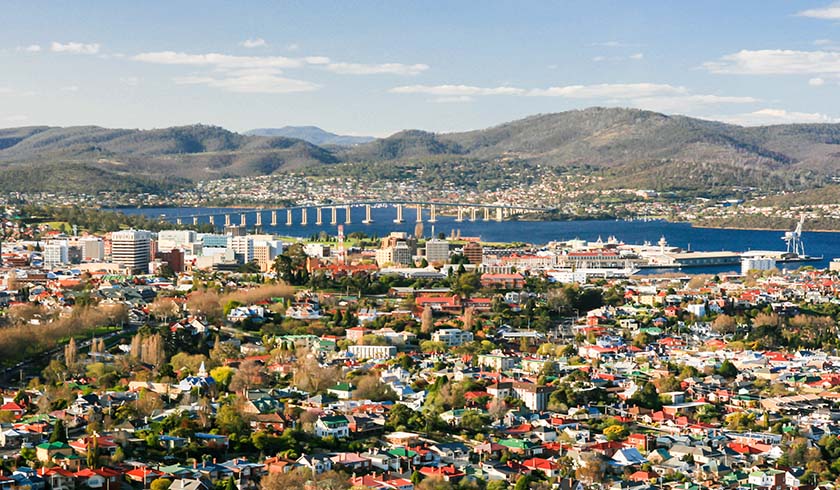Capital city property price update: July 2020
House prices across Australia have fallen by 2 per cent and unit prices are down even further, at 2.2 per cent in the June quarter. But on a city-based scale, how is each capital city faring?

The June quarter results are the first quarter to show the impact of the pandemic, the latest edition of the Domain House Price Report has revealed.
Domain has noted that all major capital cities have seen unit prices fall across the June quarter.
House prices also fell across most cities, barring the Adelaide, Canberra and Hobart markets.
But despite the losses, the impacts “have been minimal”. The report conceded that more drastic potential price falls have been buffered by significant government stimulus, mortgage holidays and the continued low interest rates supporting home values that have also kept distressed and urgent sales low.
So how is each capital city tracking?
Sydney
House prices are down 2 per cent, or almost $23,000 to a median house price of $1,143,012.
Unit prices are down slightly less, by 1.9 per cent, or $14,000 to a median price of $735,417.
While Sydney prices are higher than they were in 2019, Domain revealed house prices are still $55,000 below the 2017 peak. Unit prices are also down $52,000 in comparison with the same period.
Dr Powell says: “Price expectations have changed rapidly in recent months, with more vendors adjusting asking prices downwards to seek a timely sale. In June, 15.2 per cent of sellers reduced asking prices, three times higher than the same time last year. The proportion of properties discounted is a leading indicator of price movement, evidence that further price weakness lies ahead.”
Melbourne
House prices in Melbourne are down 3.5 per cent to a median price of $881,369.
Units have also fallen, but at half the rate – down just 1.7 per cent to a median price of $537,345.
According to Domain, it’s the Melbourne market’s first fall recorded since early 2019, but it’s also the deepest fall across all Australian capital cities.
Dr Powell says: “Melbourne’s property market outlook has adjusted in recent weeks as the city enters its second lockdown. The full impact of the first economic shutdown was clearly evident in the June quarter. Sales activity, listings and clearance rates fell in April. However the rebound was swift as restrictions eased, confidence lifted from the April lows, vendors returned, and more buyers decided it was a good time to purchase – nationally rising to a six-month high. The second lockdown will stall this momentum temporarily.”
Brisbane
Brisbane’s house market has buffered a value drop better than Sydney or Melbourne, reporting a value drop of just 1.4 per cent to a median price of $582,847.
It meant house prices in the Greater Brisbane area fell by approximately $8,000.
The same could not be said about the city’s unit market, which saw a value drop of 4.1 per cent to a median price of $375,285 – equivalent to more than $16,000.
According to Domain, Brisbane is showcasing a “two-speed property market” – Brisbane City, Moreton Bay, Scenic Rim and Somerset house prices all fell over the quarter, while Ipswich and Logan remained stable.
Dr Powell says: “Prior to COVID-19, there was promising growth in prices for Greater Brisbane. Although this has reversed in the June quarter, the fall in prices to date has been minimal considering the economic aftermath of border closures and shutdowns. An initial pullback in seller and buyer activity during the lockdown acted to underpin prices, government financial support has kept distressed or urgent sales minimal, and incentives have encouraged buying journeys to begin.”
“The outlook for residential property has improved vastly in recent weeks”
Adelaide
A 0.2 per cent growth in values was reported in South Australia’s capital over the June quarter when it came to houses, pushing the median price value to a record high of $553,036.
The same cannot be said for the city’s unit market, which fell by 2.9 per cent to $319,266 – a slip of nearly $10,000 in median value.
Dr Powell says: “Low interest rates, unprecedented government stimulus and extended mortgage repayment relief measures have sheltered house prices from any substantial falls to date. A pullback in buyer and seller activity throughout the height of the lockdown also helped. Economic headwinds could still disrupt Adelaide’s market stability, with weak employment prospects a persistent thorn in the economy, which will heighten due to health crisis.
“However, South Australia is less reliant on international tourism than other states and more reliant on interstate tourism. Once borders reopen, the state could benefit from the increase in Australians taking holidays locally.”
Perth
The Western Australian capital reported a 1.5 per cent fall across the metropolitan housing market, placing the media house price point at $522,414.
It’s a reversal of the growth trend that was visible over the March 2020 and December 2019 quarters.
Unit prices are down significantly more, reportedly 4.9 per cent lower than they were in the last quarter, to a median price of $334,284.
Dr Powell says: “Perth’s housing recovery may have paused in recent months although prices remain relatively stable considering the economic impact of the current health crisis. Improving commodity prices, particularly the state’s two biggest exports, gold and iron ore, will be a pillar of support for the economy. A rapidly shrinking supply of advertised listings will also help to rebalance the market.”
Hobart
Hobart’s housing market has stayed stable – Domain reported houses in the city are staying strong, up 1.4 per cent compared with March.
Hobart houses are now priced at a median $529,388 – which means that for the first time on record, it’s now more expensive to purchase a house in the Tasmanian capital than it is in either Perth and Darwin.
The strong pricing did not filter through to units, which reported a 1.5 per cent value drop, pushing the median price down to $429,464.
Dr Powell says: “The loss of momentum in the housing market is expected given the exposure of Hobart’s economy to tourism, the industry hardest hit by the coronavirus pandemic. Risks to the housing market remain particularly if the unemployment rate stays persistently high once government stimulus measures begin to taper. While there is no increase in urgent or distressed selling currently, risks are ahead, particularly given the extraordinary value growth and low average wage.”
Canberra
Canberra’s house market stood tall among the capital cities, seemingly untouched by the COVID-19 crisis.
House prices posted record growth, posting a 4.1 per cent increase in values, and bringing the median value up to $819,090 – it’s the first time they’ve broken the $800,000 barrier.
Continuing the countrywide trend, unit values were however down.
A loss of 1.3 per cent value has placed the median ACT apartment price at $453,750.
Dr Powell says: “The ACT has not felt the economic impact of the COVID-19 crisis to the same extent as other cities. Though the jobless rate has risen, it remains the lowest compared with other jurisdictions, supported by the high public sector employment base, where job losses have been minimal, and industries supporting the public sector.”
“A resurgence of first home buyers enticed by low interest rates and government incentive schemes have helped many on to the property ladder and supported housing activity.”
Darwin
Despite reporting a drop, Darwin’s house price values have held up better than in other capital cities.
A 1 per cent fall means the median price is now $516,213.
Unit prices have also fallen in line with other capital cities. The median price of a unit is now $241,461 – a drop of 3.7 per cent.
It means affordability in the northern city is still on its way up – with house prices more than $160,000 lower than they were during the 2013 peak.
Dr Powell says: “Darwin remains the most affordable city to purchase a house, a title it claimed last quarter for the first time since 2002. It appears units are yet to find a price trough falling further over the quarter, currently almost $245,000 below the early-2016 peak.”
